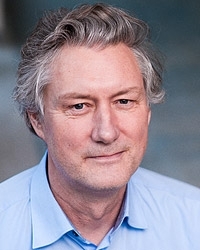
Robert Zwijnenberg
Professor emeritus Art and Science Interactions
- Name
- Prof.dr.ing. R. Zwijnenberg
- Telephone
- +31 71 527 2727
- r.zwijnenberg@hum.leidenuniv.nl
- ORCID iD
- 0000-0002-7454-6239
Robert Zwijnenberg is professor emeritus Art and Science Interactions at Leiden University. Trained in civil engineering and philosophy, he received a PhD in philosophy from the University of Amsterdam.
More information about Robert Zwijnenberg
News
-
 365 days of Leiden2022: watch the retrospective
365 days of Leiden2022: watch the retrospective -
 ‘Artists seek and research another dimension of science’
‘Artists seek and research another dimension of science’ -
 ESOF ‘Art Exploring Science’ session will connect art and science
ESOF ‘Art Exploring Science’ session will connect art and science -
 A call about: the EuroScience Open Forum (ESOF)
A call about: the EuroScience Open Forum (ESOF) -
 Stage for the Humanities
Stage for the Humanities -
 Leiden European City of Science in 2022
Leiden European City of Science in 2022 -
 Robert Zwijnenberg: ‘Don’t just talk but dare to get your hands dirty’
Robert Zwijnenberg: ‘Don’t just talk but dare to get your hands dirty’ -
 Join the Humans of Humanities film premiere in Trianon!
Join the Humans of Humanities film premiere in Trianon! -
 Leiden to stage Brave New World symposium
Leiden to stage Brave New World symposium
Reseach
In my research and teaching I focus on the role of contemporary art in the academic and public debates on the ethical, societal, political, legal and cultural implications of biotechnological innovations. Biotechnology allows us to re-design and design anew both nature, living creatures, and also the human mind and body. This forces us to reconsider our traditional views of humans and nature. What limits do we wish to impose on biotechnological intervention in nature and the human body? What view of nature and of what it means to be human informs these limits? We will need all the cultural forces at our disposal to address these questions. Any existential quest of this kind is impossible without a deep understanding of the ambiguities and complexity we need to consider. The function of art is precisely to enact these ambiguities and this complexity. I argue therefore that art, too, should have a role in our reflections on the applications and implications of biotechnology.
I specifically engage with a growing number of artists, known as bio-artists, who use the opportunities offered by the life sciences to work with new materials: living materials that traditionally do not belong to the artistic realm. The use of these living materials, or moist media, in artistic practice also implies the application of the tools of the life sciences in the arts. Much bioart literally comes out of the laboratory. The materials, tools, and technologies of the life sciences are hardly neutral, of course. They are rife with all sorts of cultural, political, social and ethical assumptions and implications that are part of this particular scientific practice. In other words, the accomplishments of the life sciences, both scientific and cultural, are directly linked with the materials, tools and technologies associated with them. Bio-art encompasses the concrete results of, say, genetic research, as well as the promises, expectations and fears it arouses. The use of these materials, tools, and technologies within an artistic context automatically means that artists have to deal with these promises, expectations and fears, including their cultural, political, social and ethical ramifications. In using biomaterials in their work, artists have also taken on board the discourses and practices of the science lab. Bio-art is the artistic outcome of the ways in which artists deal with living materials and life science practices.
In recent years the humanities have become less and less involved in setting the agenda on major issues and developments in biotechnology. In debates on the implications of developments in life sciences, scholars often find themselves at the end of the pipeline, so to speak, expected to respond critically to scientific developments or technological applications which have already been put into practice. The growing complexity and inaccessibility of science and technology make it more and more difficult for scholars in the humanities to formulate responses that go beyond those of the general public, while many also have to rid themselves of their own personal anxieties about science.
As a result of this complexity, the ethical issues and questions prompted by the results of the life sciences are being addressed or resolved more and more within the sciences themselves. This is the responsibility of, for example, ethical committees, which rely on scientific expertise and standardized protocols. Looking from the outside as a scholar and as a concerned citizen, the answers and solutions these committees provide often appear pragmatic and policy-oriented, while issues that require profound or fundamental ethical reflection seem to be largely ignored.
In my research and teaching I explore therefore new forms of productive collaboration between the humanities, the life sciences and the arts. Bioart reveals in a very specific artistic manner how, in collaborative projects between the sciences and the humanities, a new and more effective (i.e. ambiguous) understanding of our individual ethical and aesthetic responsibility for the living organisms that we can produce technologically, for example, can arise out of the openness of a work of art. Both artists and scholars should let themselves be guided by a sense of determination in articulating their responses to the life sciences as ways of critically relating to these sciences.
Over the past eight years, Zwijnenberg organized and taught the Leiden Honours Class “Who Owns Life?” , addressing ethical, legal and economic implications of biotechnological innovations. As the course emphasizes the artistic perspective as a valuable entry to the issues at stake, participants are exposed to contemporary artistic practices and production during hands-on, lab-based workshops led by bio-artists.
Professor emeritus Art and Science Interactions
- Faculty of Humanities
- Centre for the Arts in Society
- KG Moderne beeldende kunst
